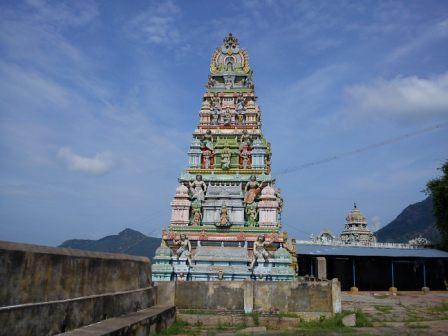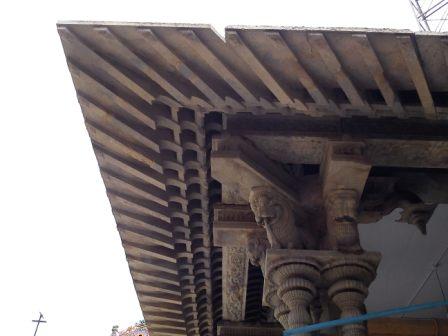20, October 2011.
Visited this temple a second time on
Jan 7th, 2023, and the long wish of worshiping Maha Vishnu of the Middle
and top level was fulfilled. This is one of the 108 Divyadesam of Vishnu
Temples. Mangalasasanam was done by Peyalwar, Thirumazhisai Alwar, Periyalwar
and Thirumangai Alwar.
வண்ண மாடங்கள் சூழ் திருக்கோட்டியூர்
கண்ணன் கேசவன் நம்பி பிறந்தினில்
எண்ணெய் சுண்ணம் எதிரெதிர் தூவிடக்
கண்ணன் முற்றம் கலந்து அளறு ஆயிற்றே.
(2)
…… Periyalwar Thirumozhi
எங்க ளெம்மிறை யெம்பிரா னிமையோர்க்கு நாயகன், ஏத் தடியவர்
தங்கள் தம்மனத்துப் பிரியா தருள்புரிவான்,
பொங்குதண் ணருவி புதம்செய்யப் பொன்களே சிதறு மிலங்கொளி,
செங்கமல மலரும் திருக்கோட்டி யூரானே.(2)
…… Thirumangal Alwar
குறிப்பெனக்குக் கோட்டியூர்
மேயானை யேத்த.
குறிப்பெனக்கு நன்மை பயக்க, - வெறுப்பனோ
வேங்கடத்து மேயானை மெய்வினைநோ யெய்தாமல்,
தான்கடத்தும் தன்மையான் தாள்
……..Thirumazhisai
Alwar Nanmukhan Thiruvanthathi
விண்ணகரம் வெஃகா விரிதிரைநீர் வேங்கடம்,
மண்ணகரம் மாமாட வேளுக்கை. மண்ணகத்த
தென்குடந்தை தேனார் திருவரங்கம் தென்கோட்டி,
தன்குடங்கை நீரேற்றான் தாழ்வு. 62
…… Peyalwar MoonRRam
Thiruvanthathi
Moolavar : Sri
Uragamellanaiyan aka Panna Mrithu Sayi &
Sowmya Narayana Perumal
Thayar : Sri
Thirumamagal
Some of the important features of
this temple are…..
The Temple faces east with a 5-tier Rajagopuram. The temple tank is in front of the temple. Sannadhi for
Emperumanar, both Moolavar and Urchavar, Thirukoshtiyur Nambigal, Shiva
Sannadhi, Bhavishyath Acharyamurthy (worshipped by Nathamuni and Yamuna
Muni), Chakkarathalwar, Alwars sannadhi, Narthana Krishna with Rukmini
& Sathyabama,
Kannan, Narasimhar and Ramar
sannidhi are on the back side. There is also a sannadhi for
Narasimhar with Hiranyakasipu. Narasimhar is with Ashtabula/eight arms. Ramanujar’s
idol is on the top of the Vimanam facing Thirukoshtiyur. From that point, Thirukoshtiyur Nambi’s residence can be seen.
On the northern side of Thayar
Sri Thirumamagal and sannadhi for Sridevi & Bhoodevi Samedha Sri Narasimhar
with 4 hands. Also, sannadhi for Srinivasa Perumal and Varadharajar. The
praharam Sannadhi for Andal, Thirukoshtiyur Nambigal, Ramanujar, Ramar, Yoga
Narasimhar, and Mahamaha is in the
Esanya direction in the temple complex. Two Chariots are in this temple.
The Vimana is constructed in three
levels. The Perumal is in these three levels, ie, Nintran, Irunthan &
Kidanthan. In the Lower level, Maha Vishnu is in a reclining posture like
Thiruparkadal, keeping the head on the south side with Sridevi and Bhudevi. In
the same sanctum, Brahma is with his three consorts, Savithiri, Gayathri, and
Saraswati; Kadamba Maharishi, the Demons Madhu and Kaidabar are at his feet, Indra,
Kasi Maharaja, Chandra’s grand son Pururava Chakravarthi, Garudan, and Naradar.
In the middle level, the sannadhi of
Upendra Narayana with Sridevi and Bhoodevi in standing posture. Only Thaila Kappu will be done instead of Abhishekam, and the walls will have beautiful paintings.
Upendra Narayana with Sridevi and Bhoodevi
In the third level, sannadhi for
Sridevi and Bhoodevi Samedha Sri Para Vasudevan is also called Paramapatha
Nathar.
Stucco image of Sridevi and Bhoodevi Samedha Sri Para Vasudevan on the Vimanam
The Utsava murti is called Sowmya
Narayana Perumal. Hence the temple was called in the name of Utsavar.
Utsavar on the 10days Vaikunda ekadasi celebration
ARCHITECTURE
The temple measures 472 feet by
East- West and 270 feet by South – North. The Rajagopuram is 85 feet high, and the Ashtanga Moolavar vimanam is 96 feet high. The golden Kalasa is 6 feet 9 inches in circumference. The temple consists of a Sanctum sanctorum, Ardha mandapam, and a Mukha mandapam with Kannadiariai in which Urchavars Anjaneyar,
Ramachandra Murthy with Sita, and Lakshmana are kept. Ekadasi mandapam is
in front of maha mandapam. Dwajasthambam, balipeedam, and Garudalwar sannadhi are
in front of Ekadasi Mandapam.
Old Photo Thanks to The Hindu
The Ashtanga Vimana is above the
sanctum Sanctorum. The second and third levels are one above the other. Each
level was constructed like individual sannidhis with adhistanam, Bhitti, and
prastaram. The top-level area is reduced compared to the first two levels.
From greevam to Sigaram was constructed with brick. The second and third-level
sannidhis are with circumambulation passages around the sanctum sanctorum, and Jalas are provided for ventilation and lighting. Looking from outside, it is like floors over floors, with
Kostas, Vishnu kantha pilasters, kalasam, kudam, lotus petals mandi, palakai, and Pushpa pothyal. Kunjara stambas are shown between pilasters. It seems that
the temple was reconstructed during the Vijayanagara period.
Shiva’s sannidhi is at the entrance
of the Perumal temple, which has Dwajasthambam/Kodimaram and
Rishabam inside the complex.
HISTORY AND INSCRIPTIONS
As per Sivaganga District Tholliyal
Kaiyedu published by the Archaeological department, the temple existed before the 8th
– 9th Century during early Pandyas. The Natrinal Two hundred
eleven ( 211 ), was composed by Nallanthaiyar, who belongs to this Place
Thirukoshtiyur. The inscriptions recorded from this temple belong to the Pandyas,
Chozhas, Vijayanagaras, and Thanjavur Kings.
This Vatteluttu inscription ( SII – XIV, No. 49. A.R. No.
287 of 1923 ) record which is let into the wall of the store-room and is kept
bottom up, is dated in the 2 + 1st year of Sadaiya-Maran. The secondary I loop
is attached to the top of the respective consonants and not to the side. The
record that may be assigned to the time of Rajasimha must have belonged to the Siva temple at the village, though it is now found embedded in the wall of the
Vishņu temple. It registers a gift of a perpetual lamp by a certain
Anukki-Sundaravalli of Kaņņikudi in Kil-Iraniyamuttam to the god
Periya-Srikōyil-Bhatara of Tirukkõțțiyür.
Above this record is another short one registering a gift
of cows and sheep for a lamp by a merchant named Kandan-Sankaranaranan and
belonging to about the same period. The damaged portion consisting of a few
Sanskrit verses is not decipherable, and as only a few words are legible here
and there, such as Śrīgoshthinātha in line 6, no continuous sense can be made
out.
The 9th Century Vattezhuthu inscription is the earliest, which belongs to Srimara Srivallaban.
The inscription records the endowment of burning a perpetual lamp by a Lady who belongs to Kannikudi of Kiliranyamuttam. Inscriptions are also found on the
pillars of the Nachiyar Temple. As per the 12th-century inscription, Perumal on the lower level was called Kerala Singa Perumal. During the 13th
Century, the latter period of Pandyas, the temple flourished once again, and
Perumal was called Chokka Narayana Perumal. The Nattars who belong to this
place ensured the poojas to Perumal
through the income from distribution.
During the Sundara Pandya period, the endowment was created to recite Thirumozhi in the month of Margazhi, for which
donations were made.
During the Veerapandya period, an
endowment was created to conduct 5 days of Vasantha Utsavam by one Sadagoban.
Jatavarman
Srivallabha’s ( SII – XIV - No. 233, A.R. No. 285 of 1923.) reign 13th-year inscription on a pillar in the
mandapa of Nachiyar Shrine, of whose historical introduction is summarised in
the words 'Sri-meykīrttikku mēl' and registers the gift of taxes amounting to
100 panam by the Nittavar of Sõlapāndya-valanādu, a sub-division of
Keralasinga-valanādu, for burning two lamps in the temple of Sokka- nārāyaņa at
Tirukkötțiyür. This amount was
agreed to be paid annually from nälluviniyogam, along with the Nalluvari.
The temple tank was excavated by
Thandavaraya Pillai, who was working with Sivaganga King as Minister and
astrologer. Hence, the tank was called Josiyar Kulam.
The inscription in the Shiva
Sannidhi ( drd SS1601 – 1679 ), records the gift of Lands to this temple by
Raghunatha Thirumalai Sethupathi.
Ref:
1. Sivaganga District Tholliyal Kaiyedu, published by the Archaeological Department.
2. South Indian Inscriptions Volume XIV.
LEGENDS
The sthala purana is the story of the killing of Hiranyakasipu by Vishnu in the form of Narasimhar. Hiranyakashipu got a
boon that he should not be killed day or night, inside or outside the
room, and the killing person should not be a man or animal. Hence, Vishnu took the
form of Narasimhar, i.e., with a Lion's head, sitting on the door frame of a
room at the time of dusk, and killed him with his bare hands. Since
Maharishis in the form of a crowd or “Koshti” went and gave complaints to
Vishnu, this place was called Koshtiyur.
It is
believed that Shiva is in the form of Sarabeswarar, who tried to calm down
Maha Vishnu after killing Hiranyakasibu.
POOJAS AND CELEBRATIONS
Apart from regualar poojas, special
poojas are conducted on 10 days Vaikunda ekadasi. During that time, Prumal will
be taken in procession through the “Paramapatha Vayil”. Ramanujar will join in the Mukha mandapam.
Paramapatha Vayil, which will be open for 10 days during the Vaikunda Ekadasi celebration
In addition to this, Masi month, Teppa Utsavam, and Navaratri are celebrated in a grand manner. During Teppa Utsavam, devotees light lamps and take them to their houses to worship daily. It is believed that doing so will make the family happy and prosperous.
TEMPLE TIMINGS:
The temple will be kept open
between 06.00 hrs to 12.00 hrs and 17.00 hrs to 20.30 hrs.
CONTACT DETAILS:
Madhavan Swamy 9443341163, Ramanujan
9443924925, and Raja +91 4577 261103 may be contacted for further details.
HOW TO REACH:
The Thirukoshtiyur temple is on the main road between Thirupathur and Sivaganga, and all the bus stops are near it.
Thirukoshtiyur is 9 km from
Thirupathur, 29 km from Sivaganga, and 63 km from Madurai.
LOCATION OF THE TEMPLE: CLICK HERE
Sannidhis on the southeast corner view from the Ashtanga Vimanam
Thirupallithama Medai - Garland-making platform
Krishna with Bama Rukmini
Maybe Chakrathalwar
First Sannidhi immediately after the Rajagopuram
A Dravida Vimana from Adhisthanam
Sculptures on the Rajagopuram
Sculptures on the Rajagopuram
Sculptures on the Rajagopuram
Rajagopuram
--- OM SHIVAYA NAMA ---
















































